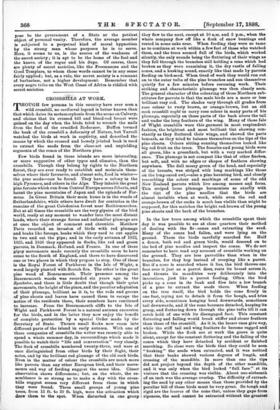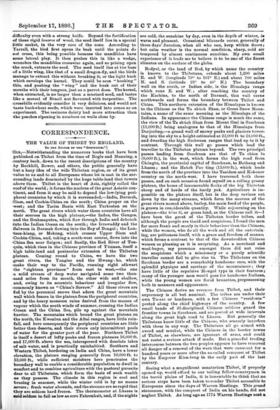CROSSBILLS AT WORK.
THOUGH few persons in this country have ever seen a wild crossbill, no ruedival legend is better known than that which dates its metamorphosis from the scene on Calvary, and claims that its crossed bill and blood-red breast were gained on the day when the birds tried to wrench the nails from the feet of the crucified Redeemer. Briffon termed the beak of the crossbill a deformity of Nature, but Yarrell watched the birds at work in captivity, and described the means by which the crossed and loosely jointed beak is used to extract the seeds from the close-set and unyielding segments of the cones of the Northern pine.
Few birds found in these islands are more interesting, or more suggestive of other types and climates, than the crossbills. Though they belong by rights to the Northern forest, they are ever ready to establish and maintain them- selves where their favourite, and almost sole, food in winter— the pine seeds—can be found. They have a colony in the high Pyrenees, and others in the Alps. They inhabit the great pine forests which run from Central Europe across Siberia, and haunt the pine mountains of Japan and the uplands of For- mosa. In Great Britain their main home is in the woods of Sntherlandshire, while others have dwelt for centuries in the remains of the great Caledonian forest near Rothiemurchus. But at all times the crossbills are the very gipsies of the bird world, ready at any moment to wander into the most distant lands, where their strange forms and unfamiliar plumage are at once the object of comment and chronicle. Matthew Paris recorded an invasion of birds with red plumage and beaks like forceps, beaks which they used to cut apples in two and eat the pipe; and in the early autumn of 1822, 1825, and 1826 they appeared in flocks, like red and green parrots, in Denmark, Holland, and France. In one of these gipsy movements made recently the crossbills seem to have come to the South of England, and there to have discovered one or two places in which they propose to stop. One of these is the Royal Forest of Parkhurst in the Isle of Wight, a wood largely planted with Scotch firs. The other is the great pine wood of Bournemouth. Their presence among the Bournemouth woods was recorded six years ago in the Spectator, and there is little doubt that though their quiet movements, the height of the pines, and the peculiar adaptation of their plumage, brilliant as it is, to the reds and greens of pine shoots and leaves have caused them to escape the notice of the residents there, their numbers have continued to increase. From the Bournemouth cliffs to the Isle of Wight and Parkhurst Forest is a natural autumn excursion for the birds, and in the latter they now enjoy the benefit -of complete protection by a special Order made by the Secretary of State. Thence small flocks now roam into -different parts of the island in early autumn. With one of these companies of crossbills the writer was recently able to spend a whole summer day, in surroundings which made it possible to watch their "life and ccnversation" very closely. The flock of crossbills numbered twenty-three, and were at once distinguished from other birds by their flight, their notes, and by the brilliant red plumage of the old cock birds. Even in the matter of colour the crossbills are mach more like parrots than any other European bird, and their move- ments and way of feeding suggest the same idea. Closer observation shows differences ; but, on the whole, the re- semblance is so strong as to make a day with the cross- bills suggest scenes very different from those in which they were found. Three small groups of young pine trees, from 12 ft. to 20 ft. high, were the attraction which drew them to the spot. When disturbed in one group
they flew to the next, except at 10 a.m. and 2 p.m., when the whole company flew off like a flock of snow buntings and rested in some oaks near. When feeding they were so tame as to continue at work within a few feet of those who watched them, and the trees seemed fall of the birds, which worked silently, the only sounds being the flattering of their wings as they fell through the branches still holding a cone which had broken as they were examining it, the dry rustle of falling cones, and a husking sound, exactly like that made by parrots feeding on bird-seed. When tired of work they would run out on to the outer tufts of the pine branches and sun themselves quietly for a few minutes before resuming work. Their striking and characteristic plumage was then clearly seen. The general character of the colouring of these Northern sub- stitutes for parrots is that the male birds are a more or less brilliant rosy red. The shades vary through all grades from rose colour to rusty brown, or orange-brown, but an old cock crossbill ought to carry rose colour in many parts of his plumage, especially on those parts of the back above the tail and under the long feathers of the wing. Many of these Isle of Wight crossbills wore this garment in most resplendent fashion, the brightest and most brilliant tint showing con- stantly as they fluttered their wings, and showed the parts beneath, as they tried to balance themselves on the tips of the pine shoots. Others sitting sunning themselves looked like big red fruit on the trees. The females and young birds were all green, like a greenfinch, but with a very marked differ- ence. The plumage is not compact like that of other finches, but soft, and with no edges or shapes of feathers showing anywhere. The dull mossy green of the head, and especially of the breasts, was striped with long markings like those on the long-eared owl,—also a pine haunting bird, and closely resembling the colour and markings of some of the odd New Zealand parrots which live among mosses and ferns. This striped loose plumage harmonises so exactly with the tint of the pine needles that the birds are almost invisible when at work, while even the red and orange-brown of the cocks is much less visible than might be supposed, for this matches the bright red-brown of the young pine shoots and the bark of the branches.
In the low trees among which the crossbills spent their day it was possible to see at close quarters their method of dealing with the fir- cones and extracting the seed. Many of the cones had fallen, and were lying on the ground. These the birds carefully searched for. Half a dozen, both red and green birds, would descend on to the bed of pine needles and inspect the cones. We do not remember to have read any account of crossbills working on the ground. They are less parrotlike than when in the branches, for they hop instead of creeping like a parrot, But if a cone is searched where it lies, the bird throws one foot over it just as a parrot does, rests its breast across it, and thrusts its mandibles very deliberately into the interstices, just like a parrot feeding. Often the bird picks up a cone in its beak and flies into a low branch of a pine to extract the seeds there. When feeding on the tree itself, the bird holds the cone firmly in one foot, trying not to detach it from the bough, and tries every side, sometimes hanging bead downwards, sometimes tail downwards, and if the cone becomes detached, keeping its grasp, and fluttering down through the pine tufts till it can catch hold of one with its disengaged foot. This constant fluttering and falling would break etiffer and closer feathers than those of the crossbill. As it is, the looser ones give way, while the stiff tail and wing feathers do become ragged and broken. While the flock are at work the grove is quite silent, except for the constant fluttering and the falling of the cones which they have detached by accident or finished searching. So close were the birds that they could be seen "husking" the seeds when extracted, and it was noticed that their beaks showed various degrees of length, and crossing of the mandible. In more than one the tips did not project beyond the depth of the other mandible, and it was only when the bird looked "f all face" at its visitors that the crossing was visible. About one-sixteenth of an inch was the average overlap. The difficulty of extract- ing the seed by any other means than those provided by the peculiar bill of these birds must be very great. So tough and rigid are the louvres of the cone that, unless they gape from ripeness, the seed cannot be extracted without the greatest
difficulty even with a strong knife. Beyond the fortification of these rigid louvres of wood, the seed itself lies in a special little socket, in the very core of the cone. According to Terrell, the bird first opens its beak until the points do not cross, this being possible because the mandibles have some lateral play. It then pushes this in like a wedge, wrenches the mandibles crosswise again, and so prising open the crack, extracts the seed. The seed itself lies at the base -of a little wing, like that of a small dragon-fly, and the birds manage to extract this without breaking it, or the light husk which envelops the kernel. They could be seen " husking " this, and pushing the " wing " and the husk out of their mouths with their tongues, just as a parrot does. The kernel, when extracted, is no larger than a mustard seed, and tastes like a morsel of Brazil nut flavoured with turpentine. The orossbills evidently consider it very delicious, and would not taste buckwheat seeds, which were inserted into cones as an -experiment. The resinous dainty had more attraction than the peaches ripening in numbers on walls close by.



































 Previous page
Previous page